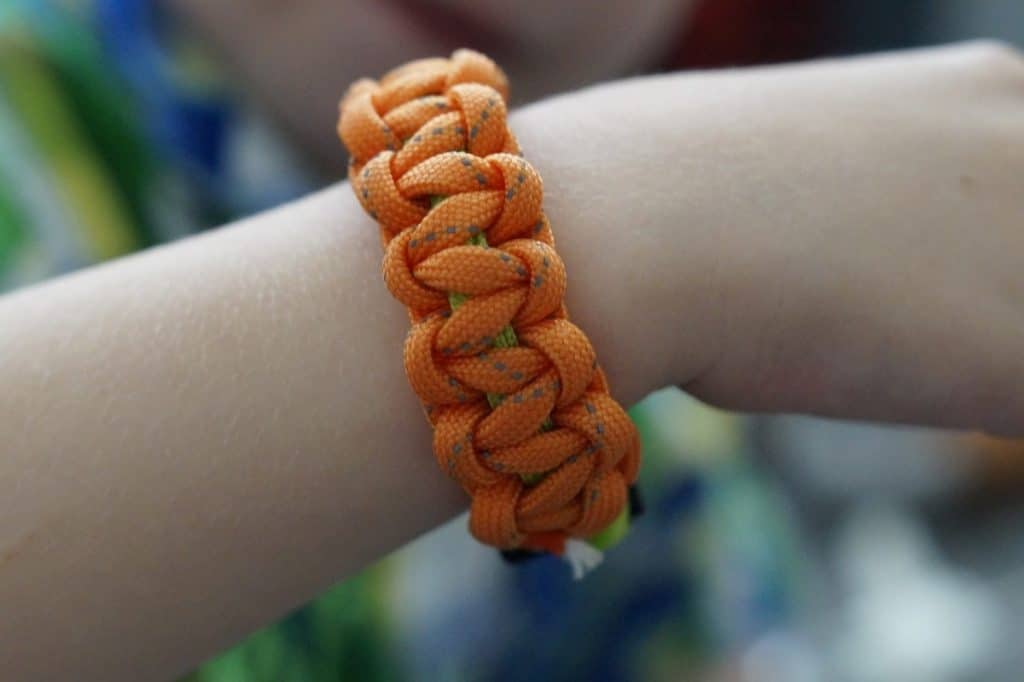Parachute cord, or paracord as it is more commonly called, is a useful bit of versatile gear that can be used for a wide array of different things.
Since paracord is made under strict military specifications, official sized parachute cord must be capable of stretching 30%. Over extended periods of time under constant stress paracord may stretch more as the elastic feature is crucial for cord that was made for parachutes.
While this gives a general rule of thumb for how much paracord can stretch while immediately in use, what does it mean for long-term stretching or use?
Turns out that can change things quite a bit based on how you use the paracord, as well as what type of paracord you use in your projects.

How the Stretch in Paracord Works
First of all, you need to understand what type of paracord you have, how you’re using it, and how the stretchiness of paracord actually works. Because if you’re using it for a very limited amount of elastic time or for hanging something over a long period of time – it radically affects how useful the paracord is and how well it is going to perform.
Paracord is graded out based on the weight it is designed for. Originally used for parachutes, military orders for paracord were based on weight stress which is why all six sizes of paracord have numbers in front of them.
Military approved sizes of paracord: 95 cord, 275 cord, 325 cord, 425 cord, 550 cord, and 750 cord
These are the sizes that are made for the military and refer to the amount of weight pressure each type of cord is supposed to be made to handle. If you want to know which one is “standard” for most use, that would be the 550 cord.
If something is advertising as paracord or standard paracord without the number chances are good that it’s 550.
Important Note: It is important to do research, especially if you are buying a non-military standard size of paracord since there’s no obligation for private companies to have the same rigorous testing as those producing military-grade paracord.
Paracord was meant to be strong, but stretchy, for short periods of time. After all these were originally made for parachutes.
So the stretch for the weight, it’s tested for relatively short periods of time. While many pages print something like “550 paracord is good for 550 lbs” that is only a partial truth.
The actual 550 means 550 lbs of pressure. So 550 lbs if there isn’t a lot of movement, pull, or anything like that. Someone or something moving at 250 lbs a lot can put down more than 250 lbs of pressure on paracord.
Now the average person isn’t going to blast out 550 lbs of weight for any amount of time, but this difference is important because it helps you understand how paracord actually works and makes sure you don’t grab paracord that isn’t up to what you need.

Immediate Stretch in Paracord
The elastic nature of paracord is a built-in feature. After all, if there was no stretch parachutes would pretty much break your back. For survival situations this makes them great for versatile one-time, quick, or short uses.
Things like hanging a basic line to build a shelter around, tying certain types of knots, or easily creating the base for rope, or tying bright strips of foil up for rescue teams to spot. These are all fantastic short-term survival uses that make paracord simple.
That immediate stretch or flexibility is capped at 30% because any more than that and it gets “too stretchy” for most conventional uses or needs.
However that same immediate stretch can make paracord a bit less practical for survival situations than many online pages or blogs would have you believe.
Long-Term Stretch in Paracord
The things about paracord is that it does stretch over the long-term. If you use it as a substitute for rope for any amount of time for hanging weight then chances are it will acquire a stretch that is permanent. Some return to previous size may happen, but not always.
One classic example that is shared quite often is this personal case study on the stretching of paracord and how much a piece of paracord stretched from 10 lbs over multiple hours.
The cord tested was a 10-foot long strand of standard 550, hanging it off a back porch with a 10 lb weight at the end.
There was an instant 9 inch stretch which is well within the regulations that the military outlines for paracord, but it does show how quickly the elastic feature of paracord kicks in.
Two hours later the paracord was the same, and then the individual testing the cord soaked it with water to see what effect that would have. Two hours later another 1.5 inches of stretch occurred, then stopped.
That was the final stretch in the test, as it was the same length the next day.
That does show that 10 lbs on a 550 cord created that level of stretch, so if you’re thinking about using paracord for strapping up a camping hammock you might want to do the math and reconsider.
Assuming your butt doesn’t hit the ground immediately upon getting in the hammock (in which case hella good job on the high and tight setup), you are almost certainly going to wake up there. Not the ideal situation (seriously just buy the hammock straps – even the best ones aren’t that expensive).
More length will mean more stretch, especially when put under constant pressure. Keep that in mind whenever you find yourself in a situation where you are considering using paracord as a substitute to rope, straps, or anything else.
How to Shrink Paracord
While this isn’t a need that too many people have, it is something that is generally popular. This could be done if you have a piece of paracord that is just a bit too long or you’re hoping to catch a little bit more use and re-gain some elastic out of a previously used piece of paracord.
Arguments on usefulness, or whether it’s worth the time/effort, aside, putting paracord into boiling water will help shrink the actual size of the paracord and slightly reduce the elasticity.
This won’t completely transform it. This is still paracord, not hard-coiled rope.
That being said, this treatment can cause the paracord to shrink a bit and while it will still be elastic the stretch won’t be quite as much. Don’t expect miracles but by the same token sometimes small treatments are all it takes to make a major difference.
What about Non-Regulation Paracord Sizes?
You would have to test out each one to see how much it would stretch. Keep in mind this doesn’t just go for the type of paracord or the weight it’s approved for. This also goes for individual companies or brands as one might have higher quality than other.
These you must test on an individual basis. There’s no one standard outside of the military grade paracord so the quality and reliability of each one can vary greatly.
If you want to know how much non-regulation paracord stretches, you will need to test it out.
In Conclusion
There you go. That is all you need to know about the stretchiness of paracord. If you’re ever in doubt, run a test or two. Paracord is relatively cheap, it is so easy to acquire, and that makes it easy to test. See how useful it is. Test out if it’s elastic enough, or too elastic, for your specific needs.
